 St. Carlo Acutis
St. Carlo Acutis
Explore the Saints
St. Augustine

Among the thinkers and writers who have articulated the Christian faith, St. Augustine is a giant.
He was born in 354 in north Africa, and at 17 went to Carthage to study rhetoric. He excelled at school out of vanity and ambition, but was consumed by the pleasures of the world. He entered into a relationship with a woman there, who bore him a son.
His mother, Monica, whose feast day was yesterday, prayed without ceasing for his conversion and reform. He began to find disillusionment in his studies and worldview and sought teaching positions elsewhere, ending up in Milan. There he came to know the bishop, Ambrose, who was well-educated and eloquent. Augustine attended Ambrose’s sermons out of pure curiosity, but the preaching began to leave a mark on his heart and mind.
At the same time that he began to see truth in Christiantiy, he was intimidated by the difficulty of living a Christian life and did not have the will to convert from the pleasures of his loose living. His famous conversion experience, detailed in his work, Confessions, happened when he was filled with shame after talking with friends about the heroism of saints. He had a sudden urge to seek guidance from the Bible. Reading Paul’s encouragement to put aside drunkenness and to put on Christ, Augustine was surrounded by peace and his anxiety and hesitation disappeared. He told his mother immediately, who rejoiced and praised God; he was baptized soon after.

Augustine grew in his faith and was eventually named bishop. His contributions to religious life and the advancement of spirituality and theology cannot be overstated. His works still form the bedrock of much of theological study. He died on this date in 430 amid the political and social turmoil of the fall of the Roman empire.
Part of the human condition is the struggle to direct our will towards ultimate goodness. The good things of this world—the pleasures of the body such as good food and drink—are certainly of God, but they are limited goods. If they take a central place in one’s life, they can become a distraction, as Augustine experienced, because they replace God for us instead of pointing us to God.
Augustine finally mastered his own will after years of letting it run free among the world’s pleasures. May we find the same order in our lives and receive the same grace, that we might also love the ultimate and lasting good, God, with all of our hearts.
St. Augustine is named a doctor of the Church, a title given to 38 saints who are known for elucidating the faith by their words or example; he is known as the Doctor of Grace for his understanding and cooperation with God’s grace. St. Augustine is the patron saint of brewers, printers, and theologians.
Relics of St. Augustine rest in the reliquary chapel in the Basilica. In the top image, St. Augustine appears in a statue above the southeast entrance to Dillon hall. He holds a quill, to signify his foundational writing, and a heart, which represents the subject of much of his thought—the nature of love. He is also depicted in the Basilica in several places, as well as in this stained glass image from the chapel in the Eck Hall of Law.
St. Augustine, you explored the depths of human and divine love—pray for us!
To learn even more about Saint Augustine, watch this video lecture from the McGrath Institute for Church Life at the University of Notre Dame.
Search Saints
 St. Carlo Acutis
St. Carlo Acutis
 St. Joseph of Cupertino
St. Joseph of Cupertino
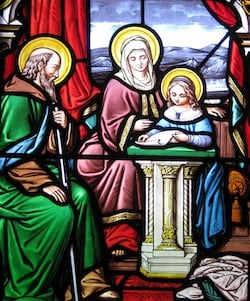 Sts. Anne and Joachim
Sts. Anne and Joachim
 St. Robert Bellarmine
St. Robert Bellarmine
 Sts. Cornelius and Cyprian
Sts. Cornelius and Cyprian
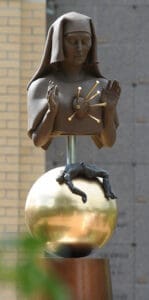 Our Lady of Sorrows
Our Lady of Sorrows
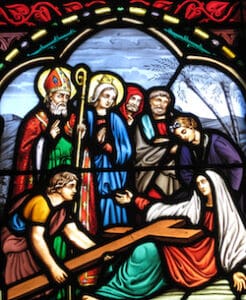 The Exaltation of the Holy Cross
The Exaltation of the Holy Cross
 St. John Chrysostom
St. John Chrysostom
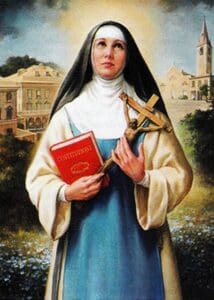 Blessed Victoria Strata
Blessed Victoria Strata
 St. John Gabriel Perboyre
St. John Gabriel Perboyre
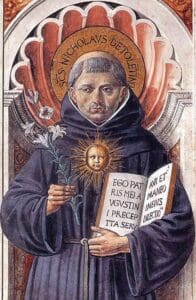 St. Nicholas of Tolentino
St. Nicholas of Tolentino
 St. Peter Claver
St. Peter Claver
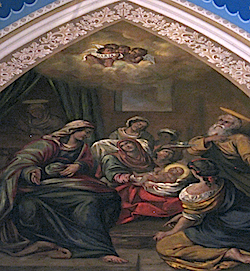 Feast of the Birth of Mary
Feast of the Birth of Mary
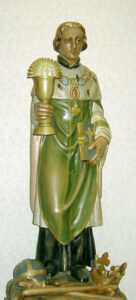 St. Cloud
St. Cloud
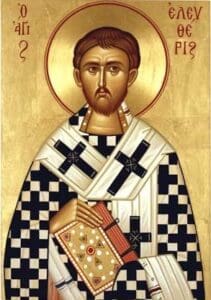 St. Eleutherius
St. Eleutherius
 St. Teresa of Calcutta
St. Teresa of Calcutta
 St. Rose of Viterbo
St. Rose of Viterbo
 Pope St. Gregory the Great
Pope St. Gregory the Great
 Blessed Jean-Marie du Lau and the Martyrs of September
Blessed Jean-Marie du Lau and the Martyrs of September
 St. Anna the Prophetess
St. Anna the Prophetess
 St. Pammachius
St. Pammachius
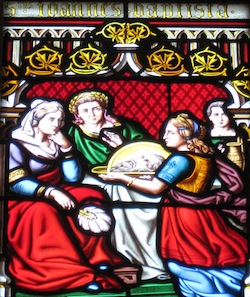 Feast of the Beheading of John the Baptist
Feast of the Beheading of John the Baptist
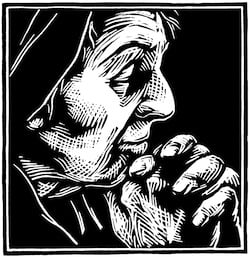 St. Monica
St. Monica
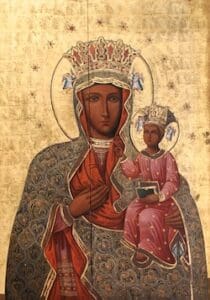 Our Lady of Czestochowa
Our Lady of Czestochowa

